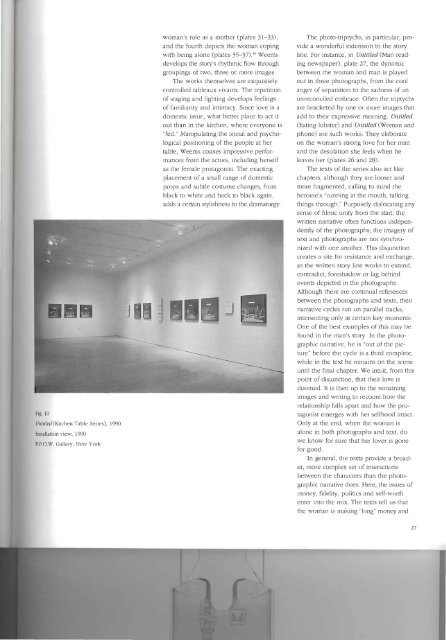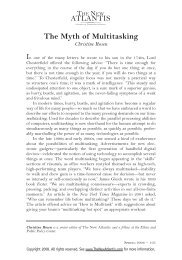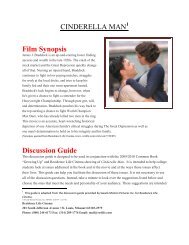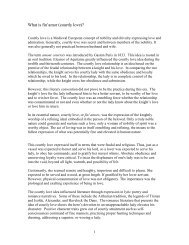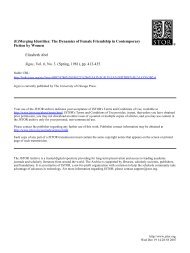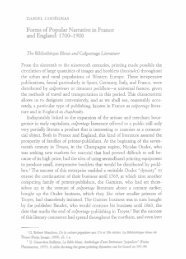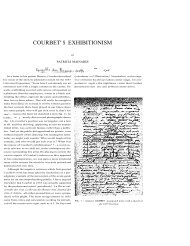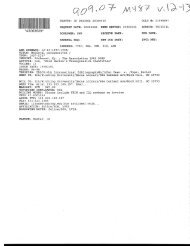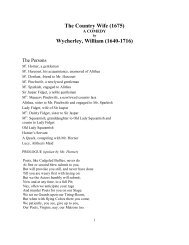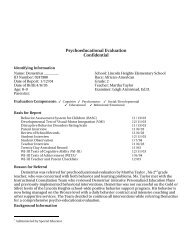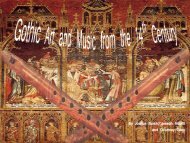CARRIE MAE WEEMS - People Search Directory
CARRIE MAE WEEMS - People Search Directory
CARRIE MAE WEEMS - People Search Directory
You also want an ePaper? Increase the reach of your titles
YUMPU automatically turns print PDFs into web optimized ePapers that Google loves.
Fig. 10<br />
Ul1lilledCKirchen Table Series), J990<br />
Inswllalion view, J990<br />
P.P.O.W. GallelY, New York<br />
woman's role as a mother (plates 31-33\<br />
and the fourth depicts the woman coping<br />
with being alone (plates 35-37).39 Weems<br />
develops the story's rhythmic flow tlu'ough<br />
groupings of rwo, three or more images.<br />
The works themselves are exquisitely<br />
controlled tableaux vivants. The repetition<br />
of staging and lighting develops feelings<br />
of familiarity and intimacy. Since love is a<br />
domestic issue, what better place to act it<br />
out than in the kitchen, where everyone is<br />
"fed." Manipulating the social and psychological<br />
positioning of the people at her<br />
table, Weems coaxes impressive performances<br />
from the actors, including herself<br />
as the female protagonist. The exacting<br />
placement of a small range of domestic<br />
props and subtle costume changes, from<br />
black to white and back to black again,<br />
adds a certain stylishness to the dramaturgy.<br />
The photo-triptychs, in particular, provide<br />
a wonderful extension to the story<br />
line. For instance, in Untitled (Man reading<br />
newspaper), plate 27, the dynamic<br />
berween the woman and man is played<br />
out in three photographs, from the cool<br />
anger of separation to the sadness of an<br />
unreconciled embrace. Often the triptychs<br />
are bracketed by one or more images that<br />
add to their expreSSive meaning. Untitled<br />
(Eating lobster) and Untitled (Woman and<br />
phone) are such works. They elaborate<br />
on the woman's strong love for her man<br />
and the desolation she feels when he<br />
leaves her (plates 26 and 28),<br />
The texts of the series also act like<br />
chapters, although they are looser and<br />
more fragmented, calling to mind the<br />
heroine's "running at the mouth, talking<br />
things tlu·ough." Purposely dislocating any<br />
sense of filmic unity from the start, the<br />
written narrative often functions independently<br />
of the photographs; the imagery of<br />
text and photographs are not synchronized<br />
with one another. This disjunction<br />
creates a site for resistance and exchange,<br />
as the written story line works to extend,<br />
contradict, foreshadow or lag behind<br />
events depicted in the photographs<br />
Although there are continual references<br />
berween the photographs and texts, their<br />
narrative cycles run on paraJlel tracks,<br />
intersecting only at certain key moments.<br />
One of the best examples of this may be<br />
found in the man's story In the photographic<br />
narrative, he is "out of the picture"<br />
before the cycle is a third complete,<br />
while in the text he remains on the scene<br />
until the final chapter. We intuit, from this<br />
point of disjunction, that their love is<br />
doomed. It is then up to the remaining<br />
images and writing to recount how the<br />
relationship falls apart and how the protagonist<br />
emerges with her seHhood intact.<br />
Only at the end, when the woman is<br />
alone in both photographs and text, do<br />
we know for sure that her lover is gone<br />
for good.<br />
In general, the texts provide a broader,<br />
more complex set of interactions<br />
berween the characters than the photographic<br />
narrative does. Here, the issues of<br />
money, Fidelity, politics and self-worth<br />
enter into the mix. 111e texts tell us that<br />
the woman is making "long" money and<br />
27


